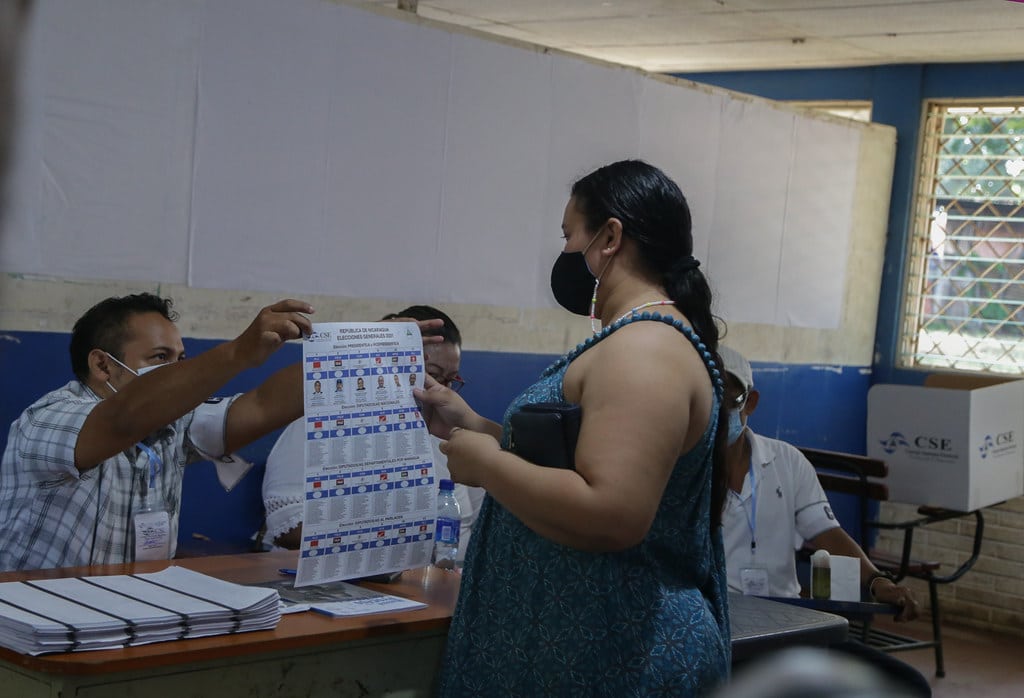Is it possible that the Sandinista National Liberation Front (FLSN) has won by a wide margin in all the polling stations in the 2021 elections in Nicaragua, regardless of the socioeconomic level and history of regions, departments or municipalities?
In this article we try to answer this question using data from the Superior Electoral Council (CSE). To do this, the database by Voting Centers was entered, which is embedded, that is, stored, on the CSE website. Although the base was not directly visible to the public, the link to this base is available as part of the HTML code, as can be seen in this video.
On the eve of the municipal elections to be held in November 2022, it is very relevant to analyze the official results of the 2021 presidential elections, which were preceded by the imprisonment of opposition leaders and banned political parties. The FSLN did not have a real opposition, since the five remaining parties did not have the slightest chance of winning the electoral contest.
The CSE reported in the bulletin 28 that the participation in the 2021 elections was 65.23% (2,921,430). If 2,921,430 votes correspond to 65.23%, then the size of the total electoral roll can be estimated at 4,476,601.
It is important to specify that the 2021 register corresponded to 87.88% of the 2017 election register. There are no analyzes available to explain this 12.78% decrease in the total number of people authorized to vote.
In turn, the percentage of people authorized to vote is equivalent to 67.7% of the total population, which corresponds to 6,610,226, according to data from the National Institute of Development Information (INIDE).
What is an embedded database?
As already noted, the 3106 Vote Center database is embedded, so it is not directly available to people who access the website.
Web pages consist of a series of instructions and texts written in HTML, a language that describes the way text is displayed in browsers. Any web page can be downloaded in .html files and then explore the code in a word editor.
In this case, the databases of the voting centers were embedded within the HTML code on the CSE page, so it was enough to download the file, find the line where the data was, process it and convert it into a file. spreadsheet, which allowed obtaining averages, standard deviations and summations by different geographical units. Why the CSE page does not have a link available to download this base is something that is not explained.
Did the FSLN win all the polling stations by the same percentage?
The distribution of the votes for the 2021 election in Nicaragua shows that the FSLN won in all the Voting Centers with a very similar total number of votes, regardless of the 153 municipalities or regions where the polling stations were located.
To have a contrast, in the presidential elections in Honduras, the Free Party won in 181 of the 298 departments, that is, in 60% of them. Meanwhile, the FSLN won in all the municipalities with an average of 77.02% of the votes and a difference between polling stations, called the standard deviation in statistics, of just 4.98%.
This coincidence in the votes received by the FSLN is accentuated when the averages by department are totaled, since the difference between them reports a standard deviation of just 1.94%.
These results show no differences between the Pacific or Caribbean regions, or between departments and municipalities traditionally more in tune with or opposed to the government party.
For their part, studies on electoral results coincide in affirming that political parties do not usually receive the same support throughout a society. The results in Nicaragua deviate from this trend and there do not seem to be explanations based on history, geography or politics that explain why in such heterogeneous territories the results are so homogeneous.
What does comparing abstentionism and support for the FSLN tell us?
In contrast to the electoral results, the estimate of abstentionism by municipalities shows important variations.
As abstentionism for each of the 153 municipalities is not available, a first step was to take the total population by municipality, information available on the website of the Nicaraguan Institute for Economic Development (INIDE), as already noted. Second, the total number of votes per municipality was obtained from the embedded database. Third, the total number of people who voted in each municipality was divided by the total of the approximate municipal register, which resulted in the estimate of participation, with which abstentionism was calculated. Only the size of the register for the municipality of Kukra-Hill, in the South Caribbean, was slightly adjusted.
The results obtained show that abstentionism varies considerably by region, department and municipality. For example, the highest percentages of abstentionism are recorded in the North Caribbean Coast Autonomous Region (71.24%) and in the South Caribbean Coast Autonomous Region (57.57%). Meanwhile, some departments such as León, Carazo, Rivas, Estelí and Managua show abstention rates of around 30%.
The question then arises as to whether it is possible that there are such marked variations of abstentionism and such pronounced similarities in terms of support for the FSLN. Again, the studies show that this possibility is practically nil, since electoral participation and support for a certain party show variabilities associated with party traditions, territorial differences, sociocultural traits, living standards, among others.
How different are the electoral results in Nicaragua, Honduras and Costa Rica?
The comparison with the elections held in Honduras and Costa Rica can be useful to form an opinion about the results in Nicaragua. In Honduras, the Free Party won with 46.68% and a standard deviation between municipalities of 20.52%.
In the case of Costa Rica, the National Liberation Party obtained 28.12% of the votes in the first round, with a standard deviation of 17.04%; in the second round, the Social Democratic Progress party obtained 53.54% with a deviation of 12.39%.
In both Honduras and Costa Rica, the winning party in the presidential elections received unequal support depending on the canton and province, as they are called in Costa Rica. The standard deviation in Honduras even quadruples the results reported by the CSE in Nicaragua. In other words, the results in Nicaragua are far from the trends observed not only in the literature, but also in neighboring countries.
More participation, more support for the FSLN?
This study also analyzed whether the increase in electoral participation had a significant weight in the support received by the winning party. In the case of Nicaragua, as the percentage of participation increased, the number of votes obtained by the FSLN also increased.
Meanwhile, in Honduras as in the second round in Costa Rica, the increase in participation did not imply an exponential increase in the number of votes received by the winning party, since not all those who come together in the elections vote for the same party.
The following scatter diagrams of the winning parties in the elections show that, in the cases of Honduras and Costa Rica, greater participation does not ensure greater support for the same party. In contrast, in Nicaragua the increase in participation favors only the FSLN.
Does the CSE report two different final results?
In the database finding, the comparison between abstentionism, participation and support for the FSLN show results that contrast with the trends found in studies on the subject and with the results in Honduras and Costa Rica. These contrasts sow even more doubts about the 2022 municipal elections.
It is important to emphasize that this analysis is based on data published by the CSE, that is, anyone, regardless of their political views, can make the same tabulations and arrive at the same results. So these are findings, not opinions.
This analysis could not end without mentioning that the votes by parties reported by the CSE on its website do not coincide with the database by Voting Centers that was found embedded in the CSE website itself. The FSLN obtained 4,812 more votes in the CSE report than in the database. In total, the CSE report includes 839 more votes than the total reported in the embedded base.
Although the differences do not alter the results of the elections, in good theory the results published by the CSE come from the database by Voting Centers, or not really?
*The authors are researchers at the University of Costa Rica (UCR).

















